child lock Hyundai Sonata
[x] Cancel search | Manufacturer: HYUNDAI, Model Year: , Model line: , Model:Pages: 271, PDF Size: 12.44 MB
Page 14 of 271
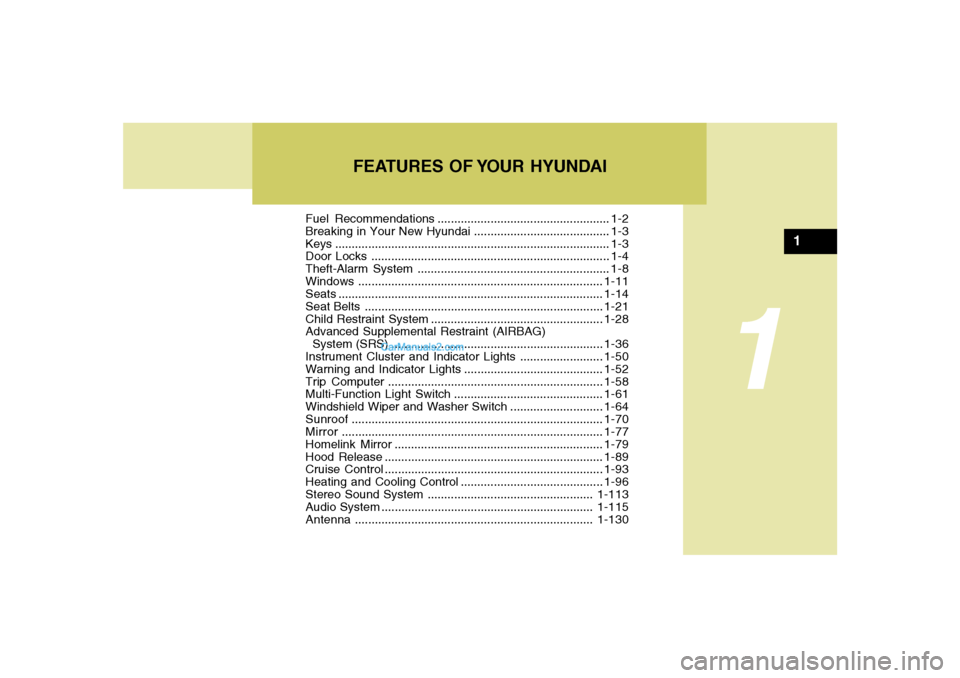
1
Fuel Recommendations.................................................... 1-2
Breaking in Your New Hyundai......................................... 1-3
Keys ................................................................................... 1-3
Door Locks ........................................................................ 1-4
Theft-Alarm System .......................................................... 1-8
Windows..........................................................................1-11
Seats................................................................................1-14
Seat Belts ........................................................................1-21
Child Restraint System ....................................................1-28
Advanced Supplemental Restraint (AIRBAG)
System (SRS) ................................................................1-36
Instrument Cluster and Indicator Lights .........................1-50
Warning and Indicator Lights..........................................1-52
Trip Computer .................................................................1-58
Multi-Function Light Switch .............................................1-61
Windshield Wiper and Washer Switch ............................1-64
Sunroof............................................................................1-70
Mirror...............................................................................1-77
Homelink Mirror ...............................................................1-79
Hood Release ..................................................................1-89
Cruise Control..................................................................1-93
Heating and Cooling Control ...........................................1-96
Stereo Sound System ..................................................1-113
Audio System................................................................1-115
Antenna ........................................................................1-130
FEATURES OF YOUR HYUNDAI
1
Page 17 of 271
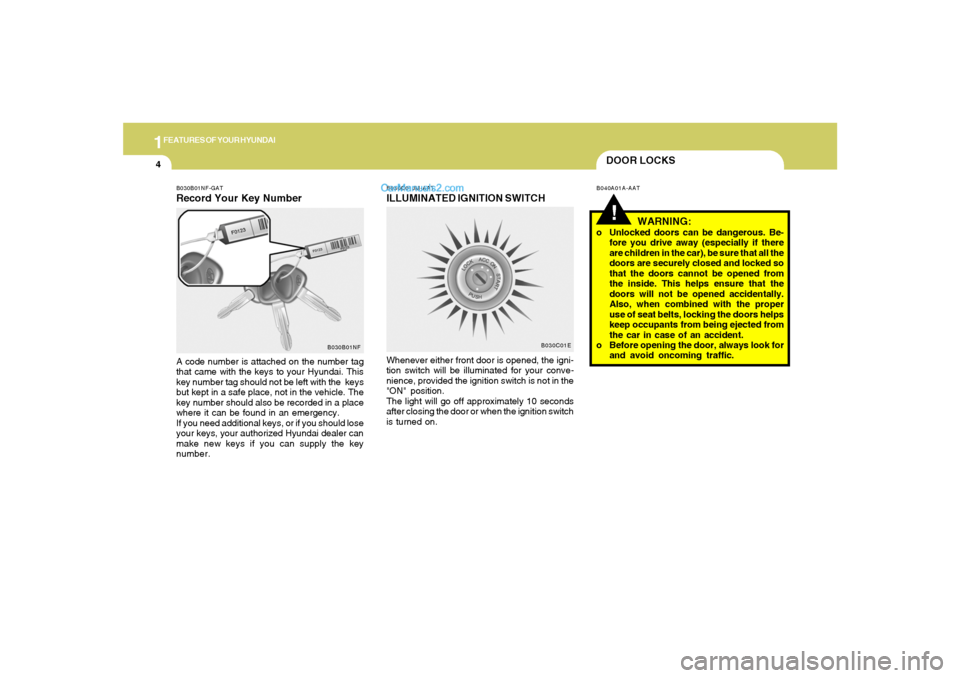
1FEATURES OF YOUR HYUNDAI4
DOOR LOCKS!
B040A01A-AAT B030C01JM-AAT
ILLUMINATED IGNITION SWITCHWhenever either front door is opened, the igni-
tion switch will be illuminated for your conve-
nience, provided the ignition switch is not in the
"ON" position.
The light will go off approximately 10 seconds
after closing the door or when the ignition switch
is turned on.
WARNING:
o Unlocked doors can be dangerous. Be-
fore you drive away (especially if there
are children in the car), be sure that all the
doors are securely closed and locked so
that the doors cannot be opened from
the inside. This helps ensure that the
doors will not be opened accidentally.
Also, when combined with the proper
use of seat belts, locking the doors helps
keep occupants from being ejected from
the car in case of an accident.
o Before opening the door, always look for
and avoid oncoming traffic.
B030B01NF-GATRecord Your Key NumberA code number is attached on the number tag
that came with the keys to your Hyundai. This
key number tag should not be left with the keys
but kept in a safe place, not in the vehicle. The
key number should also be recorded in a place
where it can be found in an emergency.
If you need additional keys, or if you should lose
your keys, your authorized Hyundai dealer can
make new keys if you can supply the key
number.
B030B01NF
B030C01E
Page 19 of 271
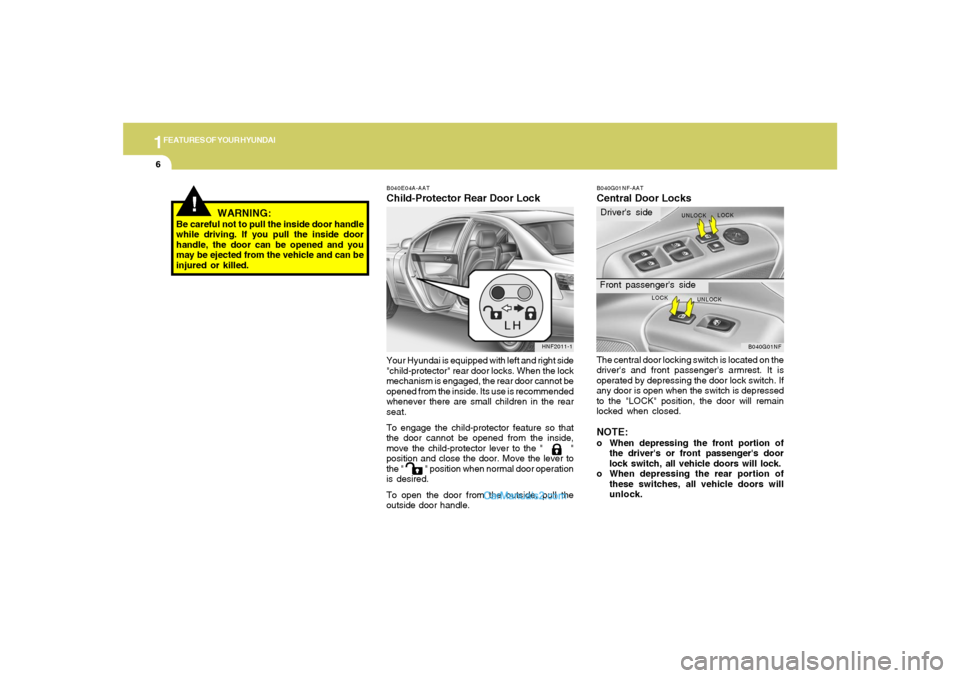
1FEATURES OF YOUR HYUNDAI6
B040E04A-AATChild-Protector Rear Door LockYour Hyundai is equipped with left and right side
"child-protector" rear door locks. When the lock
mechanism is engaged, the rear door cannot be
opened from the inside. Its use is recommended
whenever there are small children in the rear
seat.
To engage the child-protector feature so that
the door cannot be opened from the inside,
move the child-protector lever to the " "
position and close the door. Move the lever to
the " " position when normal door operation
is desired.
To open the door from the outside, pull the
outside door handle.
HNF2011-1
B040G01NF-AATCentral Door LocksThe central door locking switch is located on the
driver's and front passenger's armrest. It is
operated by depressing the door lock switch. If
any door is open when the switch is depressed
to the "LOCK" position, the door will remain
locked when closed.NOTE:o When depressing the front portion of
the driver's or front passenger's door
lock switch, all vehicle doors will lock.
o When depressing the rear portion of
these switches, all vehicle doors will
unlock.
B040G01NF
Driver's sideFront passenger's side
LOCK
UNLOCKLOCK
UNLOCK
WARNING:
Be careful not to pull the inside door handle
while driving. If you pull the inside door
handle, the door can be opened and you
may be ejected from the vehicle and can be
injured or killed.
!
Page 26 of 271
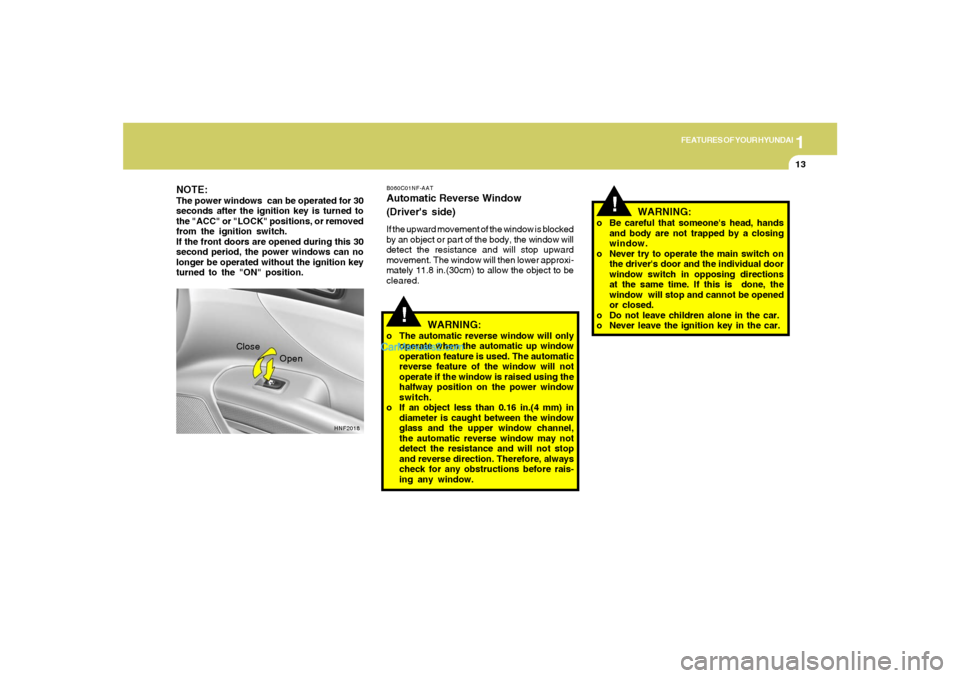
1
FEATURES OF YOUR HYUNDAI
13
!
!
HNF2018
Close
Open
WARNING:
o Be careful that someone's head, hands
and body are not trapped by a closing
window.
o Never try to operate the main switch on
the driver's door and the individual door
window switch in opposing directions
at the same time. If this is done, the
window will stop and cannot be opened
or closed.
o Do not leave children alone in the car.
o Never leave the ignition key in the car.
WARNING:
o The automatic reverse window will only
operate when the automatic up window
operation feature is used. The automatic
reverse feature of the window will not
operate if the window is raised using the
halfway position on the power window
switch.
o If an object less than 0.16 in.(4 mm) in
diameter is caught between the window
glass and the upper window channel,
the automatic reverse window may not
detect the resistance and will not stop
and reverse direction. Therefore, always
check for any obstructions before rais-
ing any window.B060C01NF-AATAutomatic Reverse Window
(Driver's side)If the upward movement of the window is blocked
by an object or part of the body, the window will
detect the resistance and will stop upward
movement. The window will then lower approxi-
mately 11.8 in.(30cm) to allow the object to be
cleared.
NOTE:The power windows can be operated for 30
seconds after the ignition key is turned to
the "ACC" or "LOCK" positions, or removed
from the ignition switch.
If the front doors are opened during this 30
second period, the power windows can no
longer be operated without the ignition key
turned to the "ON" position.
Page 32 of 271

1
FEATURES OF YOUR HYUNDAI
19
!
B100A01NF-AATSEAT WARMER (If Installed)The seat warmer is provided to warm the front
seats during cold weather. With the ignition key
in the "ON" position, push either of the switches
to warm the driver's seat or the front passenger's
seat.
During mild weather or under conditions where
the operation of the seat warmer is not needed,
keep the switches in the "OFF" position.NOTE:o The seat warmer may not operate if the
ambient temperature is warm.
o If the seat warmer doesn't operate when
the ambient temperature is lower than
75.2°F (24°C), it must be checked at an
authorized dealer.
B100A01NF
WARNING:
Do not turn on the seat warmers, if the seat
is occupied by someone who cannot moni-
tor the temperature and turn off the seat
warmer, if it becomes too warm. The seat
warmers should not be turned on when
children, the elderly, ill people, and sleep-
ing people occupy the seat.
B110A01NF-GATFOLDING REAR SEATBACKSo To unlock the seatback, pull the seatback
release lever, then pull forward on the
seatback panel.
o When you return the seatback to its upright
position, always be sure it has locked into
position by pulling and pushing on the top of
the seatback.
B110A01NF-A
Page 37 of 271

1FEATURES OF YOUR HYUNDAI24
B190A01NF-AATSEAT BELTS-Front Passenger and Rear
Seat 3-Point System with Combination
Locking Retractor
To Fasten Your BeltCombination retractor type seat belts are in-
stalled in the rear seat positions to help accom-
modate the installation of child restraint systems.
Although a combination retractor is also installed
in the front passenger seat position, Hyundai
strongly recommends that children always be
seated in the rear seat. NEVER place any infant
restraint system in the front seat of the vehicle.
This type of seat belt combines the features of
both an emergency locking retractor seat belt
and an automatic locking retractor seat belt. To
fasten your seat belt, pull it out of the retractor
and insert the metal tab into the buckle. There
will be an audible "click" when the tab locks into
the buckle. When not securing a child restraint,
the seat belt operates in the same way as the
driver's seat belt (Emergency Locking Retrac-
tor Type). It automatically adjusts to the proper
length only after the lap belt portion of the seat
belt is adjusted manually so that it fits snugly
around your hips. When the seat belt is fully
extended from the retractor to allow the instal-
lation of a child restraint system, the seat belt
operation changes to allow the belt to retract, but
not to extend (Automatic Locking Retractor
Type). See page 1-32.
B180A01NF-AATSEAT BELT-Driver's 3-Point System with
Emergency Locking Retractor
To Fasten Your BeltTo fasten your seat belt, pull it out of the retractor
and insert the metal tab into the buckle. There
will be an audible "click" when the tab locks into
the buckle.
The seat belt automatically adjusts to the proper
length only after the lap belt portion is adjusted
manually so that it fits snugly around your hips.
If you lean forward in a slow, easy motion, the
belt will extend and let you move around. If there
is a sudden stop or impact, however, the belt will
lock into position. It will also lock if you try to lean
forward too quickly.
B180A01NF
NOTE:If the driver's seat belt is not fastened when
the ignition key is turned from the "OFF"
position to the "ON" or "START" position,
the seat belt warning light will blink and the
warning chime will sound for approximately
six seconds to remind the driver to fasten
the driver's seat belt.
Page 38 of 271

1
FEATURES OF YOUR HYUNDAI
25
NOTE:o Although the combination retractor pro-
vides the same level of protection for
seated passengers in either emergency
or automatic locking modes, it is recom-
mended that seated passengers use the
emergency locking feature for improved
convenience. The automatic locking
function is intended to facilitate child
restraint installation. To convert from
the automatic locking feature to the
emergency locking operation mode, al-
low the unbuckled seat belt to fully re-
tract.
o The front passenger's seat belt warning
light on the center fascia panel blinks
until the front passenger's seat belt is
fastened to remind the front passenger
to fasten the front passenger's seat belt,
when the ignition key is turned from the
"OFF" position to "the "ON" or "START"
position.
WARNING:
o For maximum restraint system protec-
tion, the seat belts must always be used
whenever the car is moving.
o Seat belts are most effective when
seatbacks are in the upright position.
o Children must always be seatbelted in
the rear seats. Never allow children to
ride in the front passenger seat.
o The shoulder belt should be positioned
midway over the shoulder nearest the
door for the most effective protection.
Never wear the seat belt under the arm
nearest the door. Wearing the belt under
the arm nearest the door could cause
serious or fatal injuries in an accident.
o Avoid wearing twisted seat belts. A
twisted belt can't do its job as well. In a
collision, it could even cut into you. Be
sure the belt webbing is straight and not
twisted.
o Be careful not to damage the belt web-
bing or hardware. If the belt webbing or
hardware is damaged, replace it.
!
WARNING:
You should place the lap belt portion as low
as possible and snugly across your hips,
not on your waist. If the lap belt is located
too high on your waist, it may increase the
chance of injury in the event of a collision.
Both arms should not be under or over the
belt. Rather, one should be over and the
other under, as shown in the illustration.
Never wear the seat belt under the arm
nearest the door.
!
B200A01A-AATAdjusting Your Seat Belt
B200A01NF
Page 41 of 271

1FEATURES OF YOUR HYUNDAI28
!
WARNING:
o A child restraint system must be placed
in the rear seat. Never install a child or
infant seat on the front passenger's seat.
Should an accident occur and cause the
passenger side airbag to deploy, it could
severely injure or kill an infant or child
seated in an infant or child seat. Thus
only use a child restraint in the rear seat
of your vehicle.
o A safety belt or child restraint system
can become very hot if it is left in a closed
vehicle on a sunny day, even if the out-
side temperature does not feel hot. Be
sure to check the seat cover and buckles
before placing a child there.
o When the child restraint system is not in
use, store it in the trunk or fasten it with
a safety belt so that it will not be thrown
forward in the case of a sudden stop or
an accident.
o Children who are too large to be in a child
restraint should sit in the rear seat and be
restrained with the available lap/shoul-
der belts. Never allow children to ride in
the front passenger seat.
B220C02A-GATTo Release the Seat BeltWhen you want to release the seat belt, press
the button in the locking buckle.
!
WARNING:
When fastening the outboard seat belts or
the center seat belt, make sure they are
inserted into the correct buckles to obtain
maximum protection from the seat belt
system and assure proper operation.
CHILD RESTRAINT SYSTEMB230A03Y-AATChildren riding in the car should sit in the rear
seat and must always be properly restrained to
minimize the risk of injury in an accident, sudden
stop or sudden maneuver. According to acci-
dent statistics provided by the National High-
way Traffic Safety Administration (NHTSA),
children are safer when properly restrained in
the rear seats than in the front seat. Larger
children not in a child restraint should use one
of the seat belts provided.
All 50 states have child restraint laws. You
should be aware of the specific requirements in
your state. Child and/or infant safety seats must
be properly placed and installed in the rear seat.
You must use a commercially available child
restraint system that meets the requirements of
the Federal Motor Vehicle Safety Standards
(FMVSS).
Children could be injured or killed in a crash if
their restraints are not properly secured. For
small children and babies, a child seat or infant
seat must be used. Before buying a particular
child restraint system, make sure it fits your car
seat and seat belts, and fits your child. Follow
all the instructions provided by the manufac-
turer when installing the child restraint system.
B220C02NF-A
Page 45 of 271
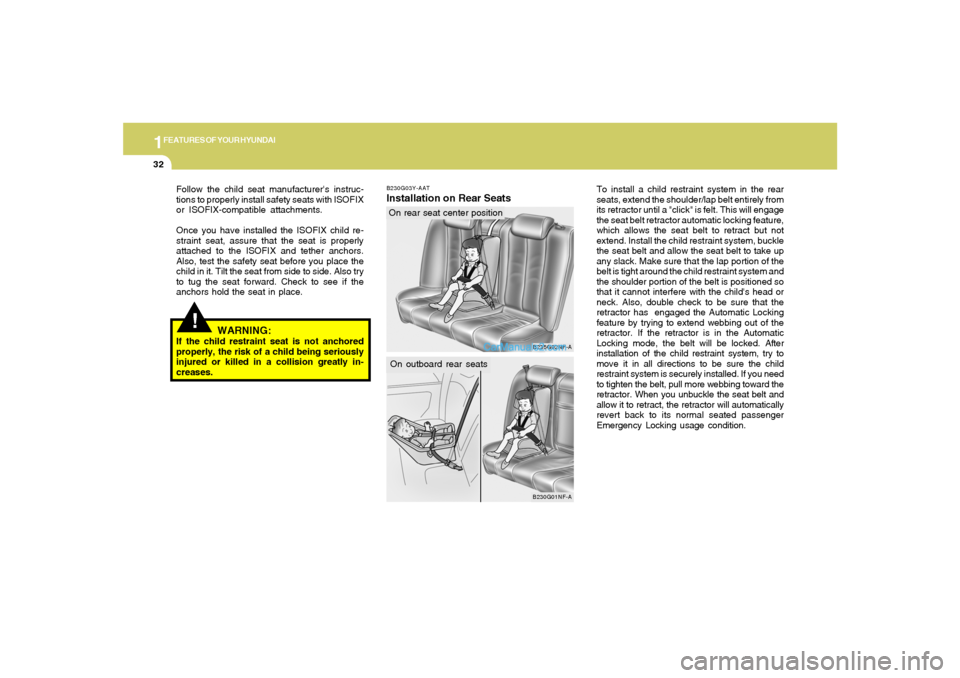
1FEATURES OF YOUR HYUNDAI32
B230G03Y-AATInstallation on Rear Seats
To install a child restraint system in the rear
seats, extend the shoulder/lap belt entirely from
its retractor until a "click" is felt. This will engage
the seat belt retractor automatic locking feature,
which allows the seat belt to retract but not
extend. Install the child restraint system, buckle
the seat belt and allow the seat belt to take up
any slack. Make sure that the lap portion of the
belt is tight around the child restraint system and
the shoulder portion of the belt is positioned so
that it cannot interfere with the child's head or
neck. Also, double check to be sure that the
retractor has engaged the Automatic Locking
feature by trying to extend webbing out of the
retractor. If the retractor is in the Automatic
Locking mode, the belt will be locked. After
installation of the child restraint system, try to
move it in all directions to be sure the child
restraint system is securely installed. If you need
to tighten the belt, pull more webbing toward the
retractor. When you unbuckle the seat belt and
allow it to retract, the retractor will automatically
revert back to its normal seated passenger
Emergency Locking usage condition.
B230G01NF-A
On outboard rear seats
!
WARNING:
If the child restraint seat is not anchored
properly, the risk of a child being seriously
injured or killed in a collision greatly in-
creases. Follow the child seat manufacturer's instruc-
tions to properly install safety seats with ISOFIX
or ISOFIX-compatible attachments.
Once you have installed the ISOFIX child re-
straint seat, assure that the seat is properly
attached to the ISOFIX and tether anchors.
Also, test the safety seat before you place the
child in it. Tilt the seat from side to side. Also try
to tug the seat forward. Check to see if the
anchors hold the seat in place.
B235G02NF-A
On rear seat center position
Page 46 of 271
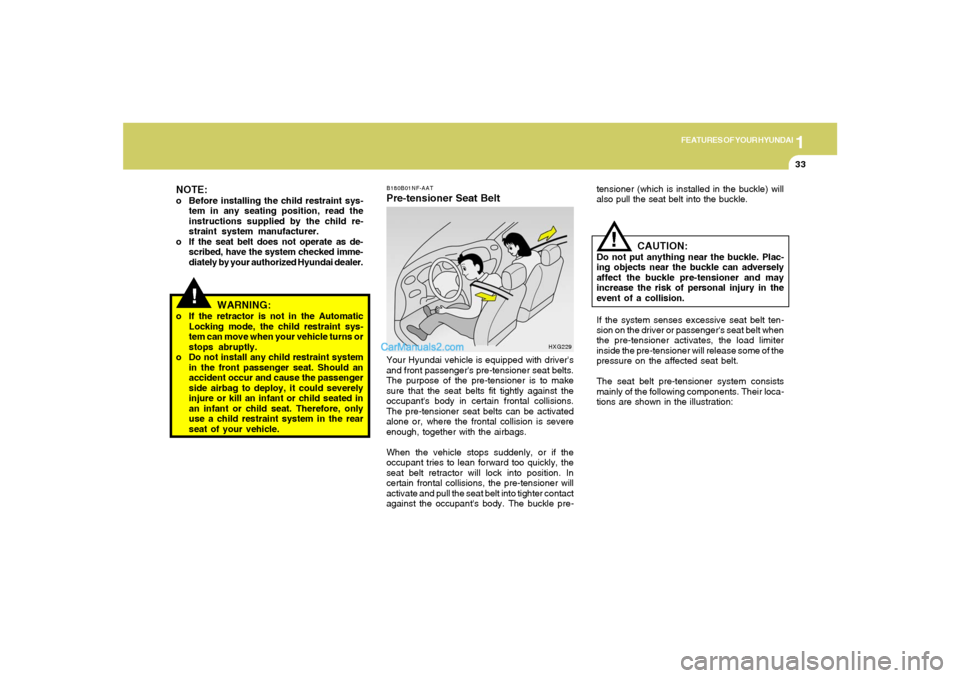
1
FEATURES OF YOUR HYUNDAI
33
!
WARNING:
o If the retractor is not in the Automatic
Locking mode, the child restraint sys-
tem can move when your vehicle turns or
stops abruptly.
o Do not install any child restraint system
in the front passenger seat. Should an
accident occur and cause the passenger
side airbag to deploy, it could severely
injure or kill an infant or child seated in
an infant or child seat. Therefore, only
use a child restraint system in the rear
seat of your vehicle.NOTE:o Before installing the child restraint sys-
tem in any seating position, read the
instructions supplied by the child re-
straint system manufacturer.
o If the seat belt does not operate as de-
scribed, have the system checked imme-
diately by your authorized Hyundai dealer.
!
B180B01NF-AATPre-tensioner Seat BeltYour Hyundai vehicle is equipped with driver's
and front passenger's pre-tensioner seat belts.
The purpose of the pre-tensioner is to make
sure that the seat belts fit tightly against the
occupant's body in certain frontal collisions.
The pre-tensioner seat belts can be activated
alone or, where the frontal collision is severe
enough, together with the airbags.
When the vehicle stops suddenly, or if the
occupant tries to lean forward too quickly, the
seat belt retractor will lock into position. In
certain frontal collisions, the pre-tensioner will
activate and pull the seat belt into tighter contact
against the occupant's body. The buckle pre-
HXG229
CAUTION:
Do not put anything near the buckle. Plac-
ing objects near the buckle can adversely
affect the buckle pre-tensioner and may
increase the risk of personal injury in the
event of a collision.
If the system senses excessive seat belt ten-
sion on the driver or passenger's seat belt when
the pre-tensioner activates, the load limiter
inside the pre-tensioner will release some of the
pressure on the affected seat belt.
The seat belt pre-tensioner system consists
mainly of the following components. Their loca-
tions are shown in the illustration: tensioner (which is installed in the buckle) will
also pull the seat belt into the buckle.